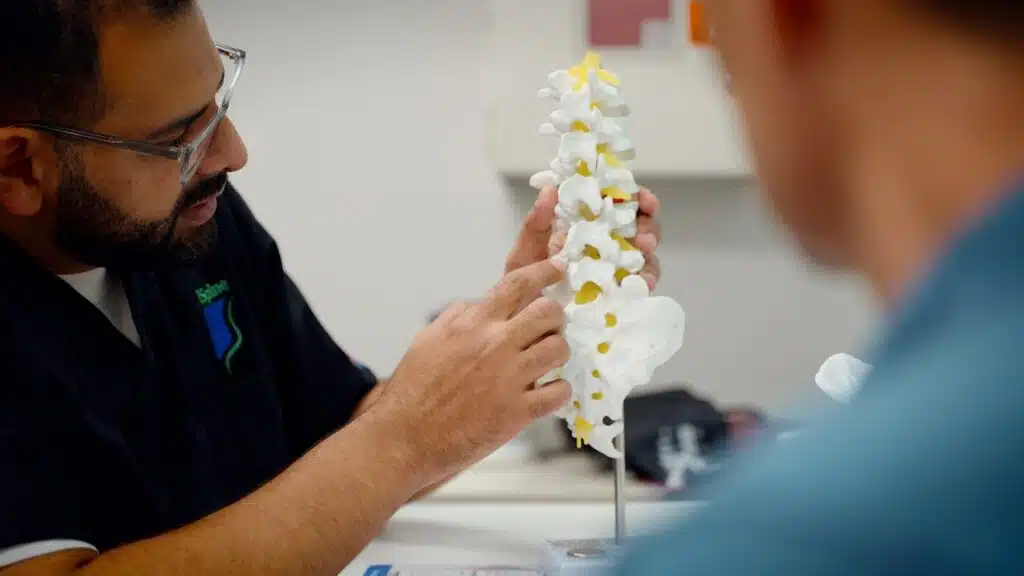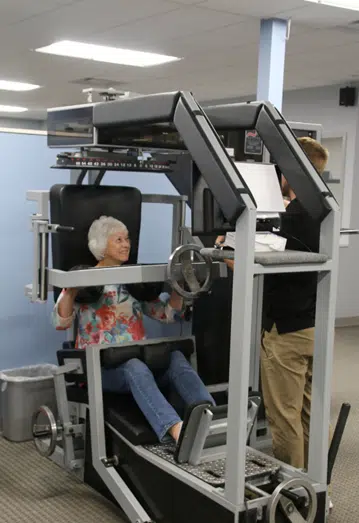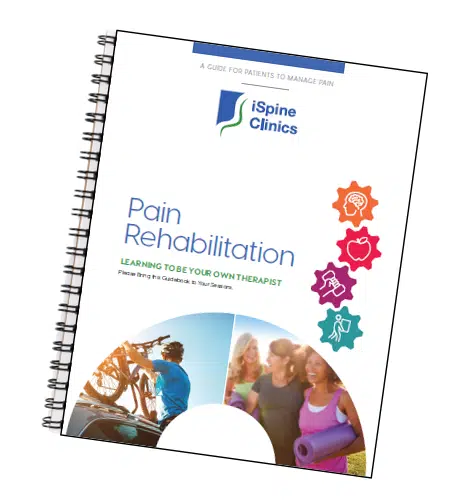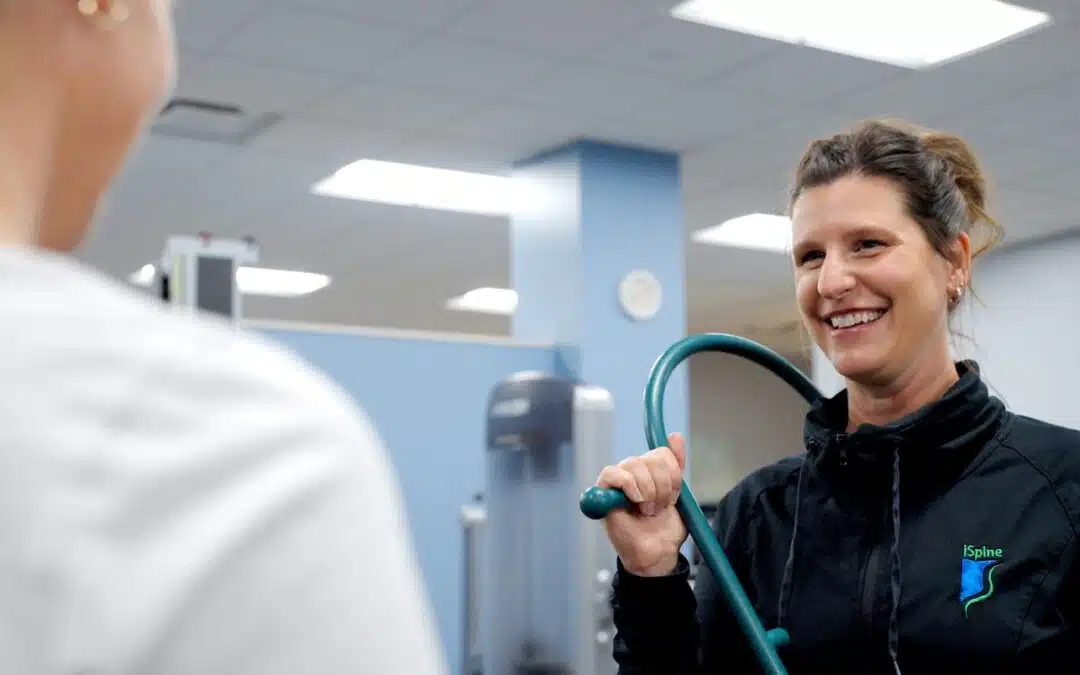Pain is complicated. Many factors affect how a person feels and functions. iSpine Rehab Clinics provides patients an opportunity to explore their contributors to pain, learn new skills, and build new habits so they may be more resilient to pain and function better.
Treating Chronic Neck and Back Pain is notoriously challenging. Patients may spend years navigating through a maze of treatment options while pain gradually erodes their function and their hope. When pain persists past a normal healing timeframe, it becomes more chronic and affects multiple systems. The patient may find themselves in a vicious pain cycle in which pain leads to lack of mobility and activity, which can then lead to strength and functional loss. The less they move, the worse they feel both physically and mentally. Many believe back surgery is the answer, and others fear there is no other option.
“Rehabilitation is not a replacement for spinal surgery, in fact, many of our referrals come from spine surgeons sensitive to exhausting nonsurgical options. In most cases, we can prevent the patient from having more invasive procedures and surgery with our approach. And, if surgery eventually is the pathway, we can be more confident that we have exhausted all other options.”
Integrated, Multi-Disciplinary Approach
iSpine Clinics’ team of physiatrists, pain interventionalists, physical therapists, and occupational therapists customize a rehabilitation program that addresses the complexity of the patient’s pain problem. Evaluating structural tissue pathology, strength, mobility, physical limitations and psychosocial risk factors helps build a platform of interventions to help move the patient forward.

Physicians take time to review a comprehensive history and medical examination regarding structural contributors to pain and provide a medical diagnosis. The Keele STarT Back Screening inventory asks the patient questions that helps providers assess the presence and severity of psychosocial barriers to recovery such as fear and worry. MedX spinal equipment measures specific range of motion and strength levels of the neck and back. Further, therapists assess functional performance of lifting, bending, and other daily tasks. This multi-disciplinary, comprehensive examination helps patients more effectively address the multi-modal contributors to their pain. This results in a tailored treatment program and well-coordinated medical plan.

“So often patients that have chronic pain bounce around to different doctors in the community without a really well-coordinated care plan. The fact that we have the ability to coordinate all non-surgical options for the patient while continuing to build physical strength and skills in therapy is just an outstanding service to our patients.”
Moving from Pain to Functional Goals
“What does recovery look like to you? If you had less pain, what would you be doing?” Many patients are focused on eliminating pain completely. While this at times can occur, it is oftentimes unrealistic. So, the trick is moving the mindset away from pain and onto function. Pain also fluctuates and we have a hard time remembering exactly how we feel day to day, but when we start putting emphasis on measurable function – the mindset changes. We talk about the value of setting activity goals early in the process. Seeing improvement in function, such as being able to play with kids, be more active, or improve work tolerances is more motivating and can get patients on a positive road to recovery.
“When you really take the time and listen to the patient, and ask them the right questions, you learn what is missing in their life. When patients can do more of their life with less pain, you know you are really making a difference.”
MedX Helps Patients Get Moving
Once valued functional goals are established, therapists use a unique method to help patients get moving successfully. iSpine Clinics are equipped with specialized MedX exercise equipment to help patients get moving by isolating spinal exercise motions. Improving spinal mobility and strength can be a challenge with typical floor exercises. MedX is used to accurately measure spinal range of motion and compare the patient’s strength to a normative goal. Using MedX to strengthen builds up physical capacity in a safe and comfortable manner so the patient may be more successful with typical exercises and daily activities. The machines are safe to use and can be modified for any type of pain problem. iSpine has specific protocols for patients that have had surgery, pain interventions, and other health issues that allow the patient to exercise in a controlled environment.
As patients experience improvement in range of motion and strength, pain also improves and activities become more manageable.

“MedX is a game changer for patients that have had other physical therapies. The ability of these machines to completely isolate the problem areas and allow patients to build strength is remarkable. The intensity that can be delivered is far better than more basic therapies. My patients are often surprised at how well they respond.”
The Mind Matters
Depression, anxiety, and fear are all common thoughts and emotions that people in chronic pain experience.
“After observing patients for years, it became clear that the results of rehab were more related to the patient’s mental mindset than their structural diagnosis. Those patients that were more fearful or more vigilant of their pain did not do as well as those that had a more positive mindset.”
Ms. Dauner created a focus group to build a solution to help patients overcome these maladaptive thoughts and beliefs about their pain which were often getting in the way of their recovery. “We call it Cognitive-Behavioral Coaching. The premise is to coach patients in a way that helps them make sense of their pain and start more helpful behaviors. I love teaching people about pain and seeing the lightbulb go off. People have so much more control of their situation than they think they do.”
Therapists use Pain Neuroscience Education (PNE) lessons with patients to help patients understand how pain is processed and experienced in the body. Using motivational interviewing techniques, they help patients prepare to make positive behavior changes to build better pain management habits. “If you can address some of the psychosocial contributors to pain like fear and worry, and help someone start moving, they really can achieve their goals,” states Dauner.
Avoiding the Boom-Bust
When it comes to activity, patients tend to either avoid activity altogether (avoidance coping), or forgo listening to their body and just push through pain (persistence coping). Both strategies usually result in more pain and frustration. At iSpine, patients work through the MedX exercise and other activities using a graded and paced approach.
“Every time we use the MedX exercise equipment we teach patients how to assess their exertion and listen to their body. We use this data to increase load, range of motion, and exertion over time to a goal.”
Therapists teach patients how to listen to their body signals to identify the difference between pain and soreness, and how to pace the loads and volumes of work to avoid flare up. Ms. Applebee notes, “We also provide reassurance that flare-ups are normal, and that increased soreness or pain does not necessarily mean something is injured.” When flare-ups occur, they work through them with self-care techniques such as icing, stretching, and recovery so they can get back on track without giving into fear. Learning how to pace activity and managing flare-ups are necessary skills for building pain resiliency.
Self-Treatment Tools
The guidebook Learning to be Your Own Therapist is a complimentary guide that patients receive and work through with their therapy team throughout their rehabilitation program.

“iSpine patients receive a comprehensive guidebook to learn many skills in managing pain. This includes a reference to a dozen relaxation mediations that they can do using a QR code, anytime, anywhere. It’s full of ideas we can draw on and try with the patient to give them tools at home for managing pain.”
Functional Training
Jason Schultz, occupational therapist, has helped build a work and functional-based training program that is integrated into the rehabilitation program.
“It’s all well and good to have the strength from the MedX machines, but we have to put that to good use. During work or functional training we work with the patient in figuring out how to lift or move actual boxes or loads, baby carriers, laundry– whatever they need to do every day. We also work through body mechanics or strategies they can do to make it easier and more comfortable.”
Using different ergonomic supports at work or home can help patients sleep, sit, or stand longer and more comfortably. Learning and practicing different ways to bend and lift with more efficiency can improve functional performance to household and work duties. Therapists practice these daily activities with the patient in the clinic to promote improved task performance.
Outcome Measures
iSpine Clinics measures patient outcomes and monitors progress throughout the rehabilitation care. It’s important to set goals and reflect on them throughout the therapy to make sure the patient is on track. Range of motion, strength, and functional goals are reviewed with the patient regularly. Mark Narveson, occupational therapist, studied outcomes to provide guidance on normative data for MedX equipment strength training.
“We looked at thousands of data points to determine normative strength levels on patients that had favorable recovery. This has been very helpful in being able to set goals for patients based on their age and body stature.”
Beyond strength levels, patients are measured on functional improvement and their recovery. On average, patients that complete the rehabilitation program report their total recovery as 75% or better.
“Being evidenced-based and showing favorable outcomes is important,” he expands, “However, it’s when the patients tell us how they have been able to get back to their life is what matters the most.”


